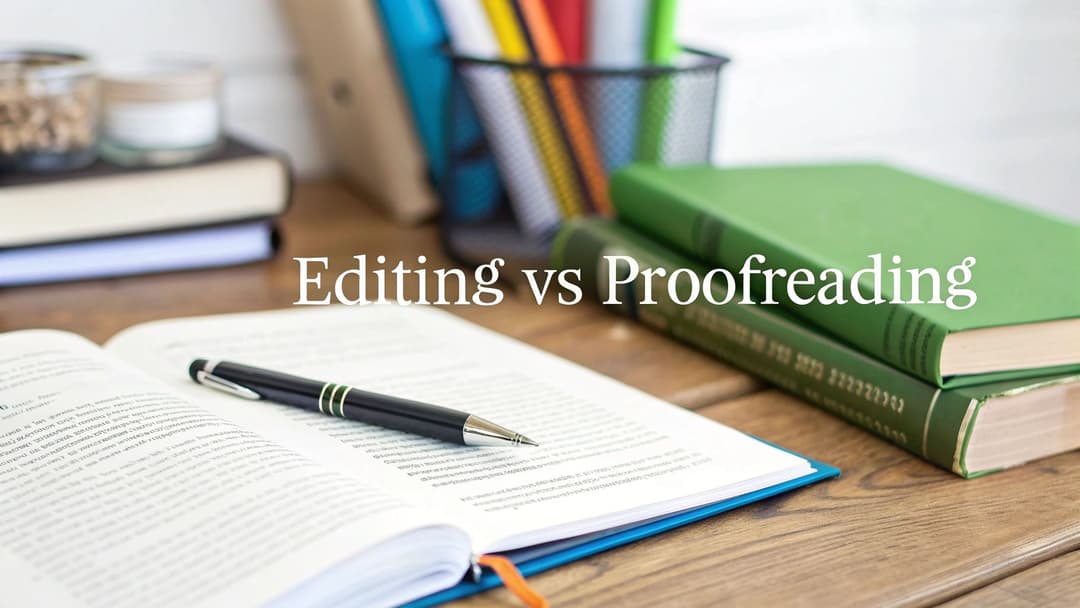
7 Advanced Writing Revision Strategies for 2025
July 31, 2025
Turning a rough draft into a polished, compelling piece of writing is an art form. While the initial creation process gets the ideas down, the real magic happens during the edit. Many writers, however, get stuck in a loop of proofreading for typos, missing the deeper structural and stylistic issues that separate good writing from great writing. The key isn't just to correct errors, but to strategically refine your work.
This guide moves beyond surface-level fixes by introducing seven advanced writing revision strategies. Each method offers a unique framework for analyzing your draft, sharpening your arguments, humanizing your voice, and ensuring your message resonates with your intended audience. From the precision of Reverse Outlining to the collaborative power of peer review, you will learn how to deconstruct and rebuild your text with purpose.
These techniques are designed to be actionable and transformative, providing a professional's toolkit for any project. Whether you're refining a research paper, a blog post, or a marketing campaign, implementing these strategies will elevate the quality and impact of your final piece. Adopting these methods is a vital step in mastering your overall content creation workflow, ensuring every draft is polished to perfection.
1. The RADDD Method
The RADDD method is one of the most systematic writing revision strategies available, prized in academic writing centers for its structured approach. It stands for Replace, Add, Delete, Delete, Delete, a framework that forces a deliberate, multi-pass review focused on aggressive cutting and strategic enhancement. Instead of making random changes, you move through your draft with a clear purpose for each pass.
This method is particularly effective for dense, cluttered first drafts, such as those produced by AI content generators or written under a tight deadline. It helps transform a functional piece of writing into something clear, concise, and impactful by prioritizing clarity above all else.
How the RADDD Method Works
The process is sequential, and its power lies in completing each stage fully before starting the next. This prevents you from trying to fix everything at once, which often leads to overlooking critical errors.
- Replace: In your first pass, hunt for weak elements. Swap out passive voice for active voice, replace clichés with fresh phrasing, and substitute vague words (like "good" or "thing") with precise, powerful alternatives.
- Add: Next, focus only on adding necessary content. Where does your argument need more evidence? Is there a gap in your logic that requires a transitional sentence? This is the only stage where you increase your word count.
- Delete, Delete, Delete: The final three passes are dedicated to ruthless cutting.
- Pass 1 (Redundancy): Eliminate repeated ideas and phrases.
- Pass 2 (Wordiness): Cut unnecessary words, like adverbs or filler phrases ("in order to," "due to the fact that").
- Pass 3 (Weak Passages): Remove entire sentences or paragraphs that don't serve your core message.
This infographic illustrates the clean, sequential workflow of the RADDD method.
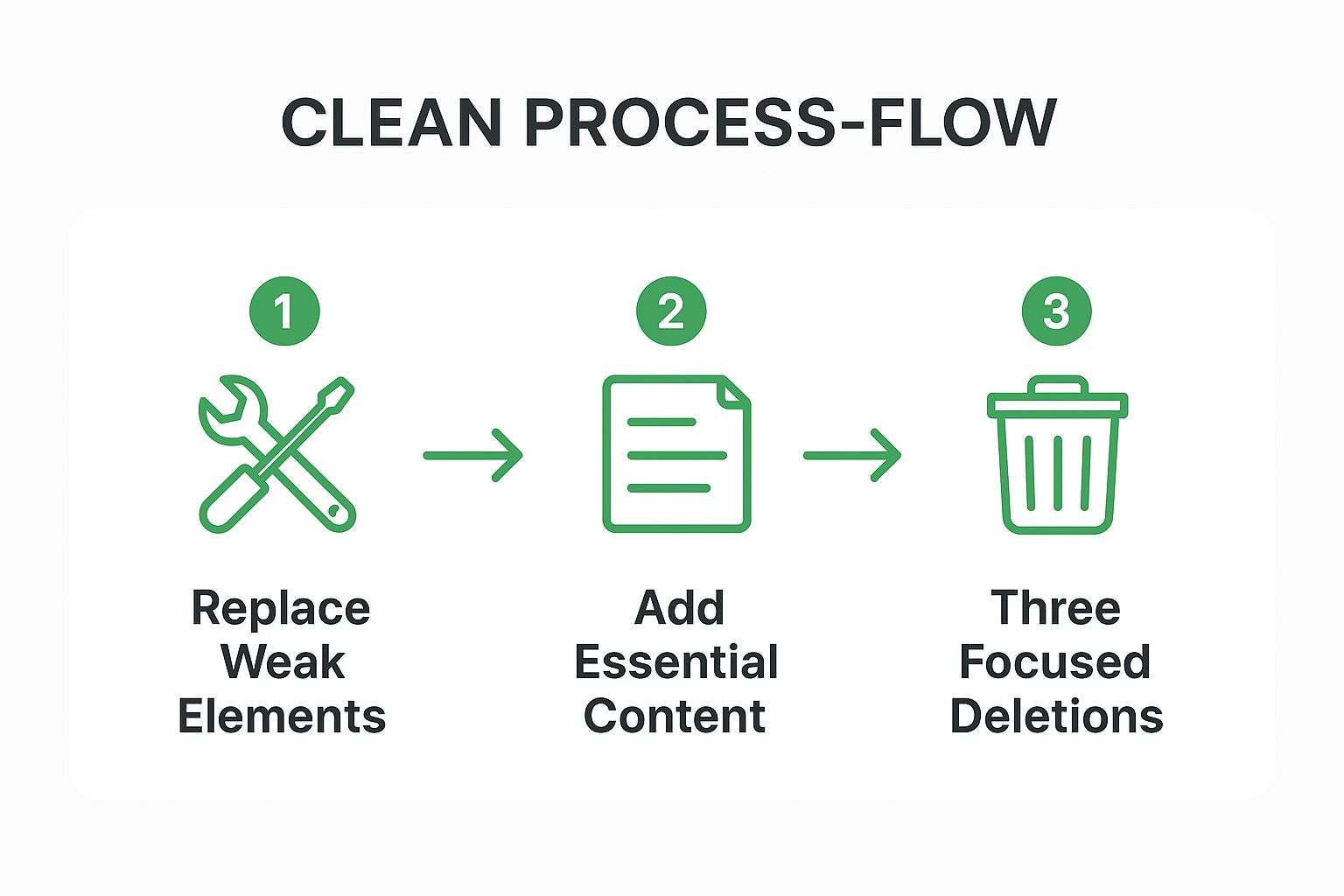 The visualization emphasizes the method's core principle: a disciplined progression from strengthening content to aggressively removing what doesn't belong.
The visualization emphasizes the method's core principle: a disciplined progression from strengthening content to aggressively removing what doesn't belong.
2. Reverse Outlining
Reverse outlining is one of the most powerful writing revision strategies for diagnosing structural problems. Instead of creating an outline before you write, you build one from your finished draft. This process reveals your article’s actual structure, not the one you intended, making it easy to spot logical gaps, poor flow, and redundant sections.
This technique is invaluable for writers who tend to overwrite or lose focus during the drafting phase. It’s particularly effective for academic researchers restructuring journal articles, content writers optimizing blog post flow, and anyone needing to transform a sprawling draft into a coherent, logically sound piece. By deconstructing your work paragraph by paragraph, you gain a high-level, objective view of its core argument.
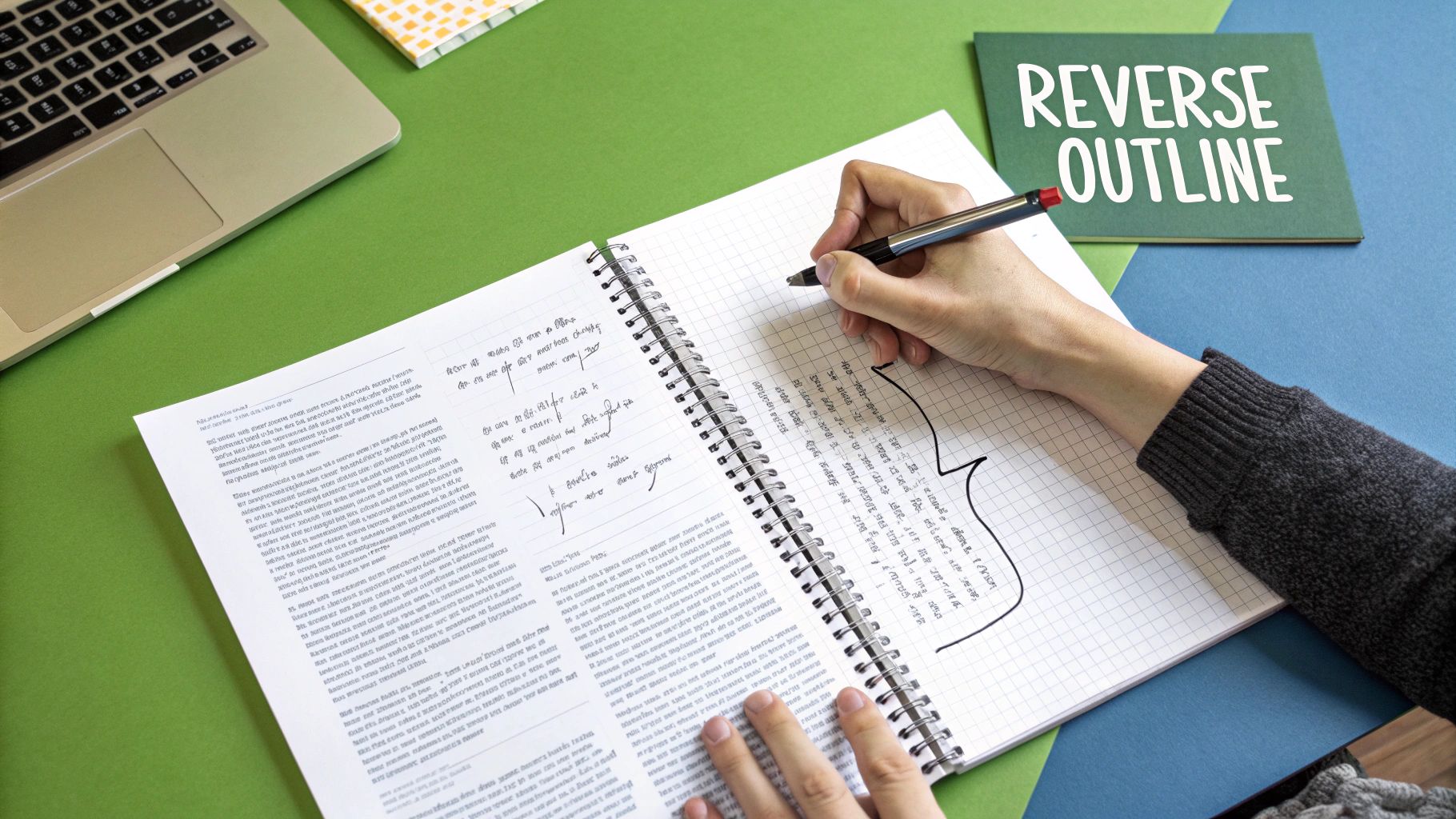
How Reverse Outlining Works
The goal of reverse outlining is to create a "skeleton" of your existing text, allowing you to analyze its architecture without getting lost in the details of the prose. The method is straightforward and can be adapted to any document type.
- Summarize Each Paragraph: Go through your draft and, for each paragraph, write a single sentence that captures its main point or purpose. You can do this on a separate document or in the margins.
- Analyze the Flow: Once you have a list of summary sentences, read them in order. Does the argument progress logically? Are there points that feel out of place or repetitive?
- Identify Connections: Note the transitions (or lack thereof) between your paragraph summaries. This is where you can see if your ideas connect seamlessly or if there are abrupt jumps in logic that could confuse the reader.
- Restructure and Refine: Use your new outline as a map to reorder, combine, or delete paragraphs. If a summary sentence reveals a paragraph has no clear point, you know it needs to be cut or rewritten.
This strategy forces you to see your writing from a reader's perspective, ensuring your arguments are well-supported and easy to follow. To get a deeper understanding of this and other editing techniques, you can explore detailed guides on how to edit a paper.
3. The SPA Method (Structure, Purpose, Audience)
The SPA method is one of the most foundational writing revision strategies, shifting the focus from sentence-level fixes to high-level coherence. It stands for Structure, Purpose, Audience, a framework that ensures the core message, organization, and reader connection are sound before you worry about minor details. Instead of correcting grammar first, you evaluate the document’s strategic effectiveness.
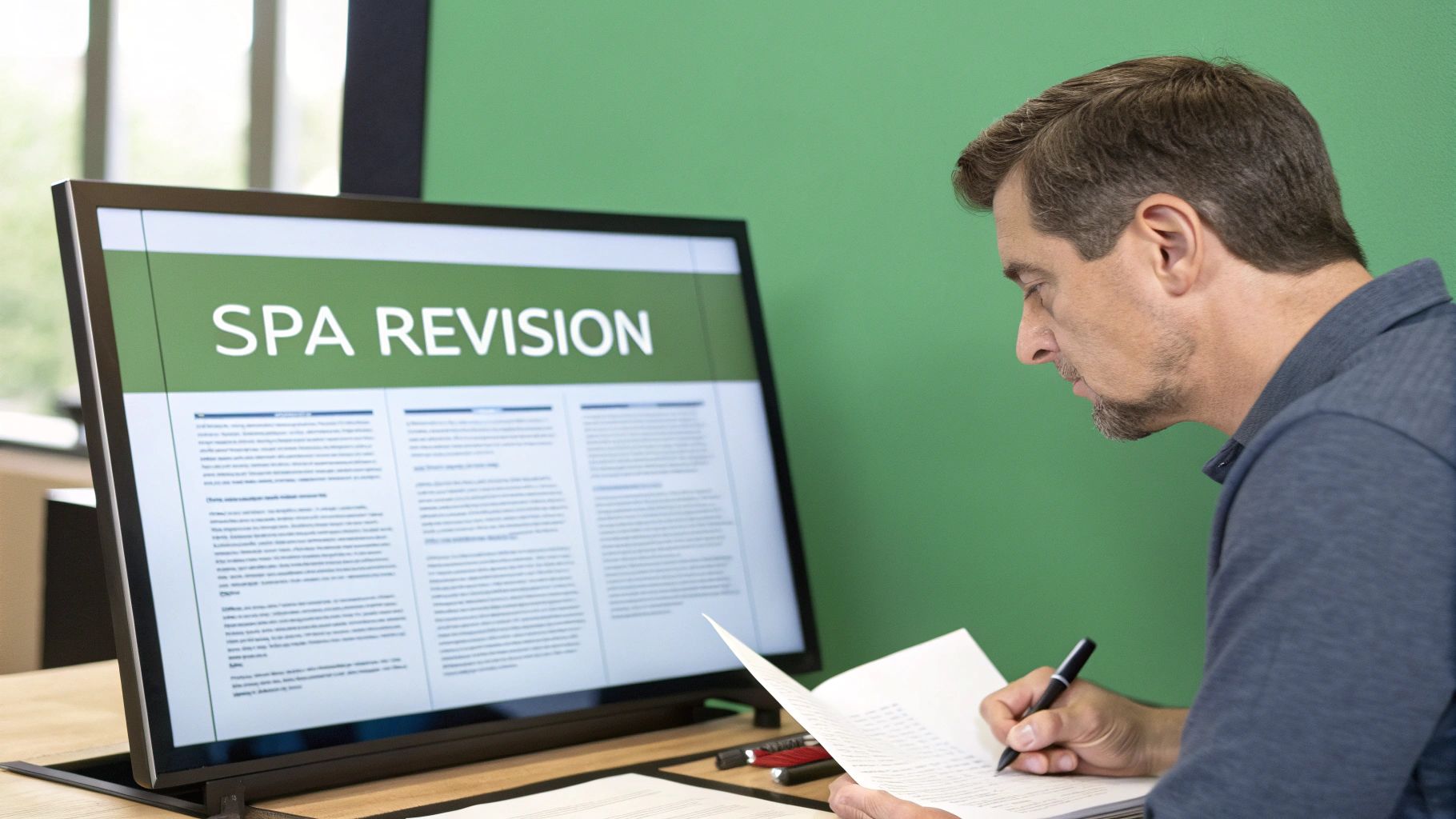
This method is especially powerful for business, marketing, and technical writing where clarity and impact are non-negotiable. It helps writers align their content with specific goals and reader expectations, transforming a draft from a simple collection of information into a persuasive and useful tool. By addressing the "big picture" first, you avoid wasting time polishing paragraphs that might get deleted later.
How the SPA Method Works
The SPA method encourages a top-down revision process. You tackle the most significant structural and strategic elements before moving to finer points, ensuring your core communication is solid.
- Structure: Your first pass analyzes the organization and flow of your content. Does the introduction clearly state the main point? Are paragraphs logically sequenced? Does the conclusion effectively summarize your argument? This stage often involves rearranging entire sections or paragraphs to improve readability and logical progression. For more insights on this, you can learn more about how to structure a blog post.
- Purpose: Next, you evaluate whether the draft achieves its primary goal. Ask yourself: What do I want the reader to know, feel, or do after reading this? Every sentence and paragraph should directly contribute to this purpose. This is where you might sharpen your thesis statement, clarify your call to action, or cut tangents that dilute your message.
- Audience: Finally, review the entire piece through your reader's eyes. Is the tone appropriate? Is the language accessible, or is it filled with jargon they won't understand? Have you provided enough context for their knowledge level? For instance, a marketing team would revise campaign materials to resonate with consumer emotions, while a technical writer would adjust documentation to be clearer for a non-expert user.
4. Hot Pen/Cold Pen Technique
The Hot Pen/Cold Pen technique is one of the most psychologically effective writing revision strategies, separating the creative act of writing from the analytical act of editing. It recognizes that our brains operate differently when generating ideas versus when refining them. The "Hot Pen" is for fast, intuitive drafting, while the "Cold Pen" is for slow, critical analysis.
This method, championed by creative writing instructors like Natalie Goldberg, prevents the self-editing paralysis that often stifles a first draft. By creating distinct phases for creation and critique, you empower yourself to write freely without judgment and later revise with precision and objectivity. It’s ideal for everything from developing a novel's raw material to refining a blog post's authentic voice.
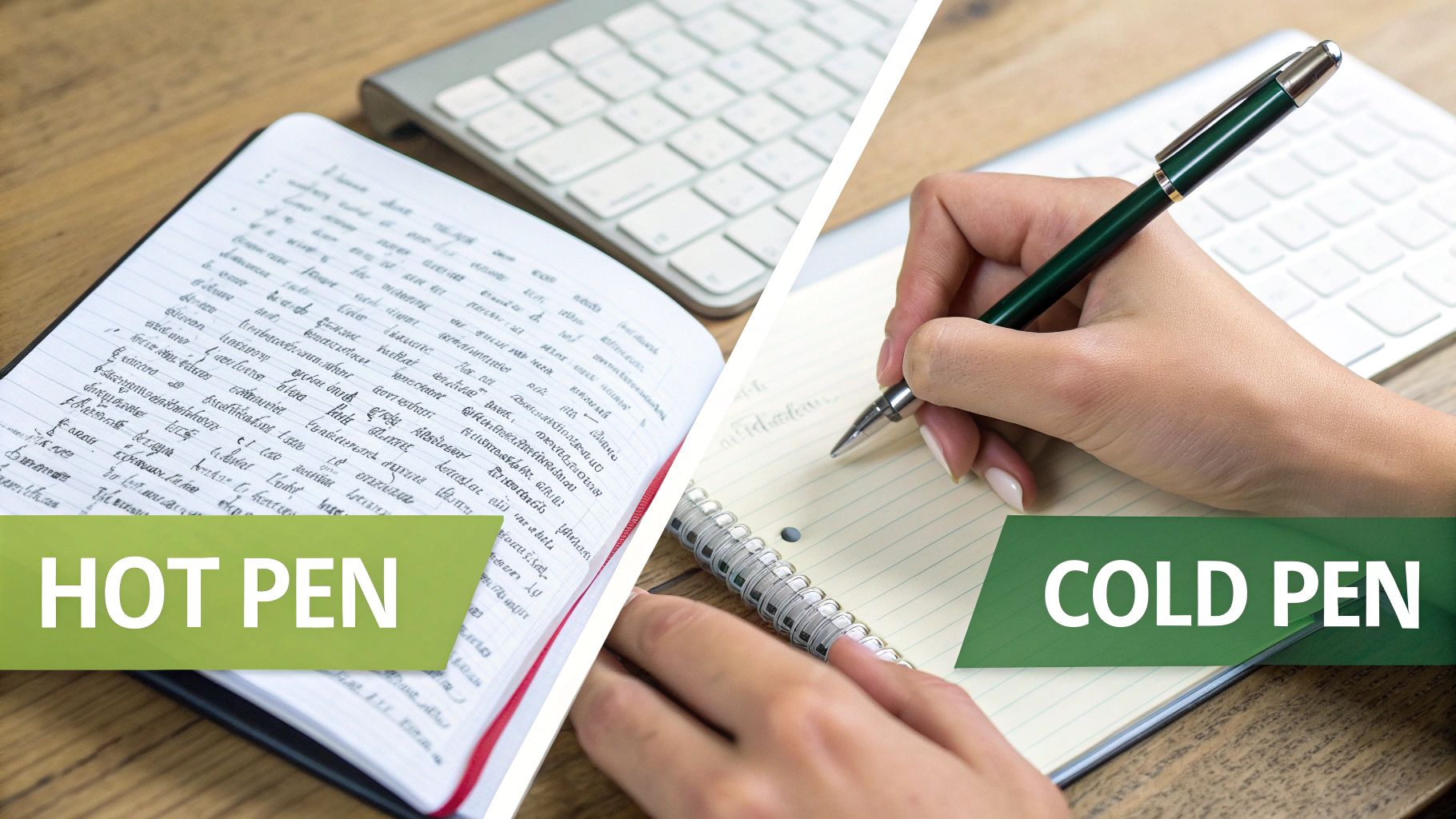
The visualization captures the core concept: separating the fiery, generative mindset from the cool, logical one to improve both processes.
How the Hot Pen/Cold Pen Technique Works
The power of this technique comes from strictly isolating the two mindsets. Alternating between these modes allows writers to harness peak creativity and peak analytical skill without one interfering with the other.
- Hot Pen (Creation): This is your generative phase. Write as quickly as you can without stopping, censoring, or correcting yourself. The goal is to get ideas onto the page, no matter how messy. Ignore grammar, spelling, and structure; just let the words flow. Screenwriters use this to draft dialogue quickly, while copywriters use it for brainstorming headlines.
- Cold Pen (Revision): After a break, return to your draft with a critical eye. This is your analytical phase. Read through slowly, looking for areas to improve clarity, structure, and impact. You'll fix typos, strengthen arguments, cut unnecessary words, and reorganize sentences. This is where you apply logic and precision to the raw material created by the hot pen.
Practical Tips for Implementation
To maximize the effectiveness of this method, create clear boundaries between the two phases.
- Set Time Limits: Use a timer for your hot pen sessions (e.g., 25 minutes) to encourage continuous writing.
- Change Your Environment: Try using different tools or locations for each phase. Write with a pen for your hot session and edit on a computer for your cold session.
- Schedule Strategically: Align your hot pen sessions with your most creative times of day and save the cold pen work for when you feel more analytical and focused.
- Don't Look Back: During a hot pen session, resist the urge to reread what you've just written. Keep moving forward to maintain momentum.
5. Peer Review and Collaborative Revision
Writing can be an isolating activity, which often leads to blind spots in our own work. Peer review is one of the most powerful writing revision strategies because it introduces fresh, objective eyes to a draft. This method involves sharing your writing with colleagues, mentors, or fellow writers to gain external perspectives on everything from argument strength to clarity and tone.
This collaborative approach is invaluable for identifying weaknesses that the original author is too close to see. It transforms revision from a solitary struggle into a constructive dialogue, leveraging collective intelligence to elevate the final product. It is particularly effective for high-stakes documents like academic papers, business proposals, or novel manuscripts, where clarity and impact are paramount.
How Peer Review and Collaborative Revision Works
The core of this strategy is structured, purposeful feedback. Rather than simply asking "What do you think?", a successful peer review is guided by specific goals and clear communication. The process helps refine ideas and polish prose through external input.
- Select Your Reviewers: Choose readers who can offer valuable insights. This might mean finding someone who represents your target audience, a subject matter expert, or a skilled writer who can comment on craft.
- Provide Clear Guidance: Don't just hand over your draft. Give your reviewers specific questions to consider. Are there gaps in the logic? Is the tone appropriate? Does the introduction grab their attention? This focuses their feedback where you need it most.
- Synthesize and Implement: You will likely receive diverse, sometimes conflicting, advice. Your job is not to accept every suggestion but to identify patterns and determine which feedback best serves your core message. For effective group work, understanding the key collaborative problem solving steps can help you and your reviewers work together productively to refine the document.
A formal peer review process can seem daunting, but even an informal feedback session with a trusted colleague can reveal critical areas for improvement that you would have otherwise missed.
6. The Layered Revision Approach
The Layered Revision Approach is one of the most effective writing revision strategies for tackling complex documents without becoming overwhelmed. Championed by professional editors and writing instructors, this method involves making multiple, distinct passes through a draft, with each pass focused on a single "layer" of the writing. Instead of trying to fix everything at once, you systematically address different issues in a logical sequence.
This approach is invaluable for large projects like thesis dissertations or long-form content, where simultaneously checking for structure, grammar, and flow is nearly impossible. It breaks down the monumental task of revision into manageable, focused stages, ensuring that both high-level and granular problems receive dedicated attention. This methodical process leads to a more polished and professional final product.
How the Layered Revision Approach Works
The power of this method comes from its structured, sequential nature. By defining a clear goal for each pass, you can edit more efficiently and thoroughly. You build a strong foundation first, then refine the details.
A typical sequence of layers includes:
- Layer 1 (The Big Picture): The first pass is for content and organization. You review the overall structure, argument, and flow of ideas. Does the draft meet its core purpose? Are the main points logically arranged? This is where you might move entire sections or rewrite your thesis statement.
- Layer 2 (Paragraph Level): Next, zoom in on individual paragraphs. Check for clear topic sentences, unified focus, and logical transitions between paragraphs. Ensure each paragraph contributes meaningfully to the section it's in.
- Layer 3 (Sentence and Word Level): This layer focuses on sentence structure, clarity, and word choice. You'll hunt for awkward phrasing, improve sentence variety, and replace vague words with precise alternatives. This pass refines the style and voice of the piece.
- Layer 4 (Proofreading): The final pass is a meticulous check for surface-level errors. You'll look exclusively for typos, grammatical mistakes, punctuation errors, and formatting inconsistencies.
You can streamline this process with a dedicated checklist. To learn more, see this detailed writing revision checklist on naturalwrite.com.
7. Read-Aloud Revision Strategy
The Read-Aloud Revision Strategy is one of the most intuitive yet powerful writing revision strategies, leveraging the brain's auditory processing to catch errors the eyes might miss. It involves reading a draft aloud to identify awkward phrasing, clunky sentences, and unnatural rhythms. When we read silently, our brains often autocorrect mistakes and fill in gaps, but hearing the words spoken forces a more critical evaluation of flow and clarity.
This method is exceptionally effective for any content intended to feel human and conversational, from marketing copy and blog posts to presentation scripts and creative fiction. It bridges the gap between the written word and spoken language, ensuring your text is not just grammatically correct but also engaging and easy to follow.
How the Read-Aloud Revision Strategy Works
The process is straightforward but requires you to slow down and listen critically to your own words. It transforms revision from a purely visual task into an auditory one, exposing issues that hide in plain sight on the page.
- Read at a Natural Pace: Don't speed-read or skim. Read the text at a comfortable, conversational speed, as if you were presenting it to an audience. This helps you notice where the rhythm feels off or where the sentence structure becomes too complex.
- Mark Stumbling Points: Keep a pen handy or make digital comments. Every time you stumble, pause awkwardly, or have to reread a sentence for clarity, mark that spot. These are clear indicators that the phrasing needs to be simplified or restructured.
- Listen for Tone and Rhythm: Pay attention to how the words sound together. Does the tone match your intended message? Is the rhythm varied and interesting, or is it monotonous? Awkward rhymes, repetitive sentence starts, and jarring transitions become much more obvious when spoken.
This approach is highly valued by speechwriters, podcasters, and children's book authors who must ensure their language is both clear and engaging when heard. It is a fundamental technique for humanizing any piece of writing. By focusing on the sound and flow, you can refine your draft into a polished, professional, and highly readable piece of content.
Revision Strategies: Side-by-Side Comparison of 7 Methods
| Revision Method | Implementation Complexity 🔄 | Resource Requirements 🔄 | Expected Outcomes 📊 | Ideal Use Cases 💡 | Key Advantages ⭐ |
|---|---|---|---|---|---|
| The RADDD Method | Moderate to High (five sequential steps, multiple passes) 🔄🔄 | Moderate (time and strong judgment needed) 🔄 | Tighter, focused writing; reduced redundancy 📊 | Academic writing, detailed revision tasks 💡 | Clear revision structure; reduces wordiness ⭐ |
| Reverse Outlining | Moderate (analytical, paragraph-level) 🔄 | Moderate (time-intensive, analytical skills) 🔄 | Identifies structure and logic gaps 📊 | Academic articles, reports, theses, blog posts 💡 | Reveals structural issues; improves flow ⭐ |
| The SPA Method (Structure, Purpose, Audience) | Low to Moderate (analytical framework) 🔄 | Low (mostly cognitive effort) ⚡ | Improved big-picture alignment to audience 📊 | Marketing, technical writing, grants, journalism 💡 | Comprehensive macro-level revision; audience focused ⭐ |
| Hot Pen/Cold Pen Technique | Moderate (requires discipline to alternate phases) 🔄 | Moderate (time and focus management) 🔄 | Balanced creativity and precision; prevents block 📊 | Novelists, screenwriters, copywriters, bloggers 💡 | Maintains flow and momentum; creative balance ⭐ |
| Peer Review and Collaborative Revision | Moderate (coordination and feedback synthesis) 🔄 | High (multiple people, time coordination) 🔄 | Diverse perspectives; objective feedback 📊 | Academic peer review, workshops, corporate docs 💡 | Provides blind spot identification; community input ⭐ |
| The Layered Revision Approach | High (multiple focused passes; systematic) 🔄🔄 | High (time-consuming and patience required) 🔄 | Comprehensive and deep revision; prevents overwhelm 📊 | Professional editing, theses, publishing agencies 💡 | Thorough coverage; customizable depth ⭐ |
| Read-Aloud Revision Strategy | Low to Moderate (simple but time-consuming) 🔄 | Low (only requires voice/time) ⚡ | Catches flow and phrasing issues; natural rhythm 📊 | Speechwriting, poetry, presentations, podcasts 💡 | Improves readability; identifies awkward phrasing ⭐ |
Elevate Your Editing and Humanize Your Voice
Navigating the journey from a rough first draft to a polished final piece requires more than just correcting typos. It demands a structured, intentional approach. The collection of writing revision strategies we've explored provides a comprehensive toolkit designed to elevate your work, ensuring it resonates with clarity, purpose, and a distinctly human touch. By moving beyond simple proofreading, you can transform the very foundation of your writing.
Each method offers a unique lens for improvement. Reverse Outlining forces you to confront the logical flow and structural integrity of your arguments, while the SPA Method keeps your writing anchored to its core structure, purpose, and audience. Techniques like the Hot Pen/Cold Pen method and the Layered Revision Approach encourage you to separate the creative and analytical phases of editing, preventing premature perfectionism and fostering a more objective eye. Similarly, reading your work aloud or engaging in peer review introduces invaluable external perspectives, helping you catch awkward phrasing and tonal inconsistencies you might otherwise miss.
Weaving Strategy into Your Workflow
The true power of these techniques lies not in using them all at once, but in selecting the right tool for the right job.
- For structural issues: Start with Reverse Outlining to diagnose problems with flow and coherence.
- For tonal refinement: Use the Read-Aloud strategy to hear how your words land and identify robotic or unnatural language.
- For comprehensive polishing: Adopt the Layered Revision Approach to tackle big-picture concerns before moving to sentence-level details.
Mastering these writing revision strategies is an investment in your ability to communicate effectively. It’s the difference between a message that is simply delivered and one that is truly felt. Whether you are a student striving for academic excellence, a marketer crafting persuasive copy, or a blogger looking to engage your audience, the final polish is what separates good writing from great writing. This deliberate process ensures your final product is not only error-free but also compelling and authentically you.
To further enhance your editing process and explore technological aids, consider integrating advanced tools. There are many powerful AI tools for writing and editing that can complement these manual strategies, helping you identify complex grammatical issues or refine your style with greater efficiency. By combining methodical human oversight with intelligent automation, you create a powerful, streamlined revision workflow that produces exceptional results.
Ready to supercharge your revision process? Natural Write instantly analyzes your text for robotic patterns and transforms it into clear, engaging, and human-sounding prose with a single click. Try Natural Write today and see how effortlessly you can elevate your drafts from good to unforgettable.
